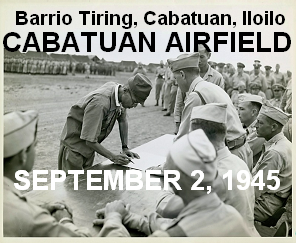
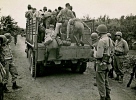
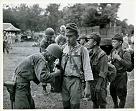
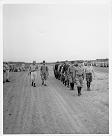
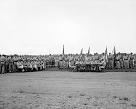
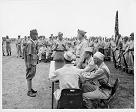
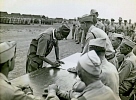
Col. Ryoichi Tozuka signs the surrender instrument
as Col. Raymond G. Stanton looks on.
Cabatuan Airfield
Barrio Tiring, Cabatuan, Iloilo
Panay Island, Philippines, September 2, 1945
|
|
- o -
|
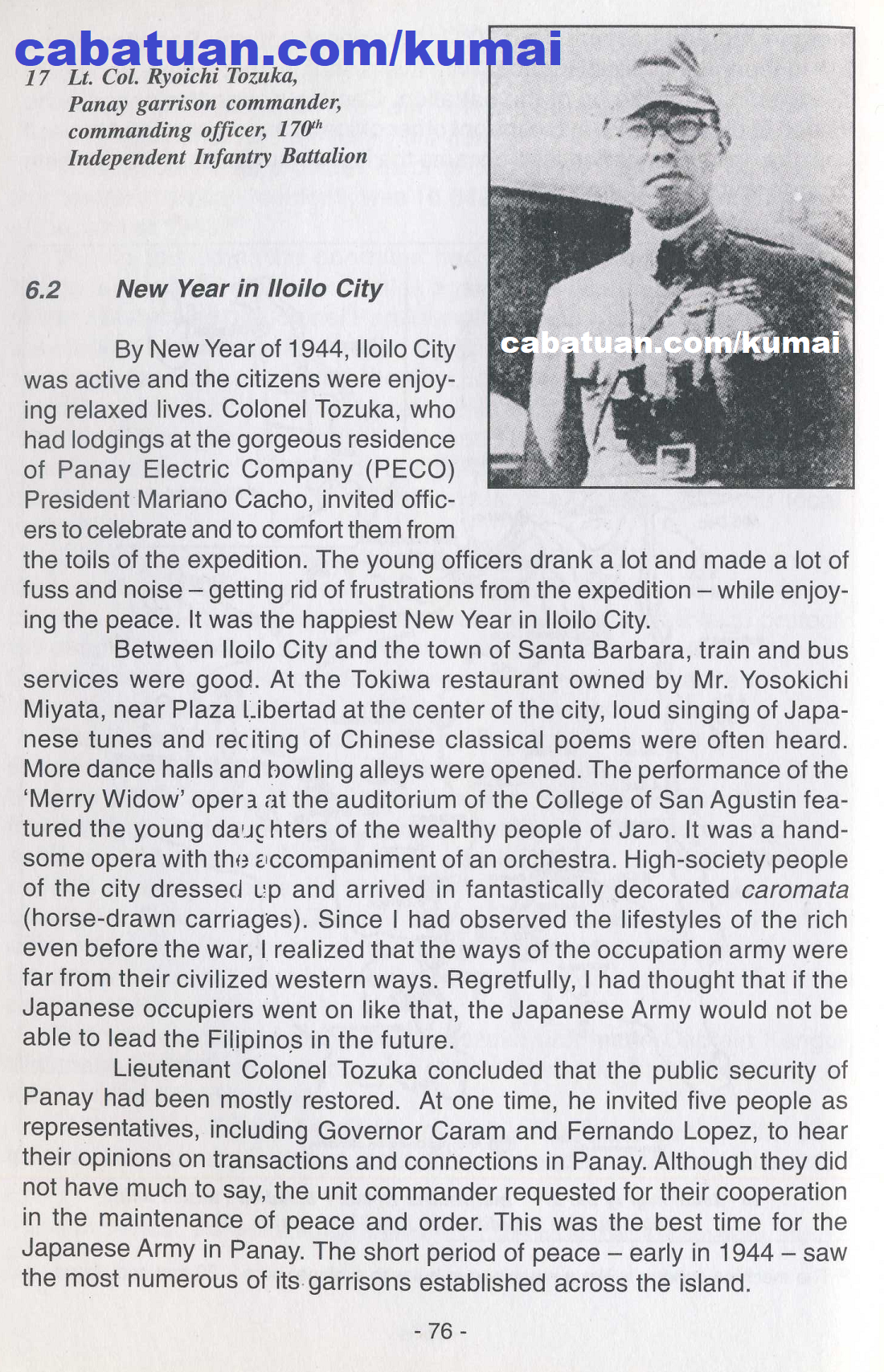
Lt. Col. Ryoichi Tozuka, Panay garrison commander, commanding officer, 170th Independent Infantry Battalion. Page 76.
|
|
6.2 New Year in Iloilo City
By New Year of 1944, Iloilo City was active and the citizens were enjoying relaxed lives. Colonel Tozuka, who had lodgings at the gorgeous residence of Panay Electric Company (PECO) President Mariano Cacho, invited officers to celebrate and to comfort them from the toils of the expedition. The young officers drank a lot and made a lot of fuss and noise getting rid of frustrations from the expedition while enjoying the peace. It was the happiest New Year in Iloilo City.
Between Iloilo City and the town of Santa Barbara, train and bus services were good. At the Tokiwa restaurant owned by Mr. Yosokichi Miyata, near Plaza Libertad at the center of the city, loud singing of Japanese tunes and reciting of Chinese classical poems were often heard. More dance halls and bowling alleys were opened. The performance of the Merry Widow opera at the auditorium of the College of San Agustin featured the young daughters of the wealthy people of Jaro. It was a handsome opera with the accompaniment of an orchestra. High-society people of the city dressed up and arrived in fantastically decorated caromata (horse-drawn carriages). Since I had observed the lifestyles of the rich even before the war, I realized that the ways of the occupation army were far from their civilized western ways. Regretfully, I had thought that if the Japanese occupiers went on like that, the Japanese Army would not be able to lead the Filipinos in the future.
Lieutenant Colonel Tozuka concluded that the public security of Panay had been mostly restored. At one time, he invited five people as representatives, including Governor Caram and Fernando Lopez, to hear their opinions on transactions and connections in Panay. Although they did not have much to say, the unit commander requested for their cooperation in the maintenance of peace and order. This was the best time for the Japanese Army in Panay. The short period of peace early in 1944 saw the most numerous of its garrisons established across the island.
While we were enjoying the temporary peace, however, the whole war situation in the Pacific further deteriorated. We did not realize that, on May 29, the garrison of Attu Island in the Aleutians had been annihilated. On November 25, the garrisons on Makin and Tarawa Islands of the Gilbert Islands in Central Pacific were also wiped out. Furthermore, on December 1, the first student unit left Japan to join battles abroad.
On the side of the guerrillas, the first US submarine that had brought weapons and other materials for them landed at Libertad then part of the town of Pandan in the province of Antique on April 30, 1943. On August 19, they received a second delivery of weapons, ammunition, communication equipment, generators, and fuel. The third supply of weapons and ammunition came on February 5, 1944, and on March 21, the fourth batch of supplies arrived. At that time, probably because of news of the massacre of the Americans at Tapaz, the submarine carried back 56 remaining Americans to Australia. By April, there were already more than 10 wireless radio bases established on Panay Island. Each landing brought from 20 to 200 tons of weapons, ammunition, medicines and other equipment; as a result, there was vast improvement in the equipment of the guerrilla forces throughout this period.
|
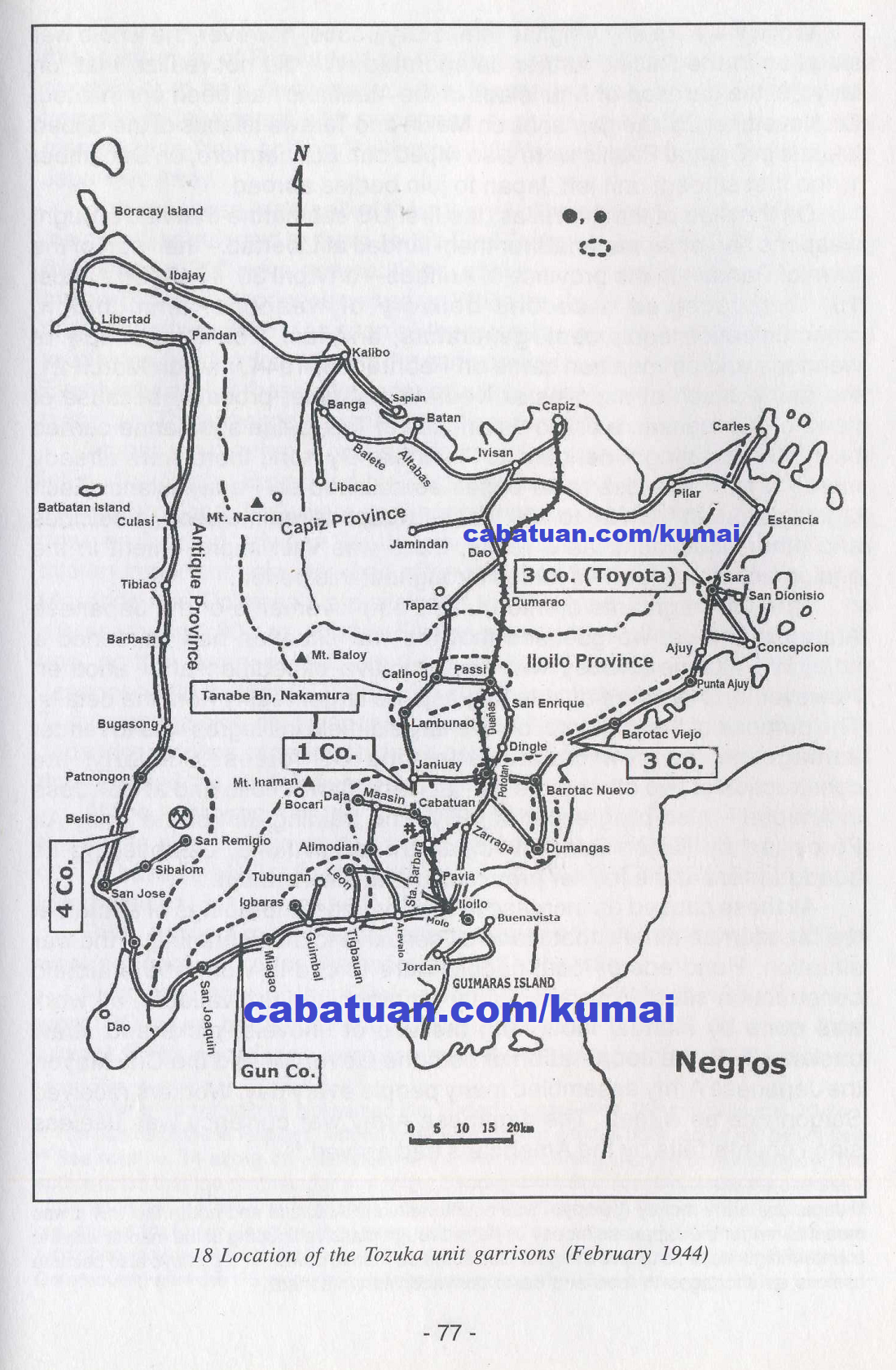
Location of the Tozuka Unit garrisons (February 1944). Page 77.
|
|
Through fragments of information on movements of the Japanese Army around us, we guessed that the war situation had worsened a little. We had been busy with one punitive expedition after another. However, that we were unable to grasp the larger reality from the details. The purpose of the construction of a large airfield in Negros was to render damage on the now counter-attacking US forces. Similarly, the construction of two other airfields at Cabatuan in Iloilo and at San Jose in Antique also progressed rapidly. The training unit of the Army Air Force led by Major General Anzai arrived in Iloilo, establishing its headquarters at the former premises of the JMA branch.
All these caused an increase in the comings-and-goings of aircraft at the Mandurriao airfield that made us sensitive to the tightening of the war situation. Hundreds of local people were forced to work at the airfield construction sites. With absolutely no machineries available, all work was done by manual labor with the use of shovels, picks and straw baskets. With the cooperation of both the Governor and the City Mayor, the Japanese Army assembled many people every day. Workers received Saigon rice as wages. The Japanese Army war currency was useless since counterfeits by the Americans had arrived.
There was no local industry at all in wartime Panay. Except for peasants, the young men of Panay had no choice to support themselves but to be a guerrilla or to be a mercenary of the Japanese Army. After the Philippines became independent with Japanese support, the policy was to adopt mercenaries from among Philippine POWs and others detained by the Japanese Army.
The Japanese Army called them the (hired men); on the other hand, the guerrillas referred to them as the Civil Defense Corps (CDC). Heeding their wishes, 300 were adopted; and, after a one-month training, they were attached to each Japanese company. While the Japanese Army was winning, they obeyed orders; but as soon as the guerrillas became active, they started to tip sides. Inside information of the garrison was made known to the guerrillas. Eventually, a lot of these escaped with weaponry or switched sides to be guerrillas. Thus, the mercenaries had disappeared.
Among the numerous cases of damage from mercenaries, the major one fell on the Sentry Squad led by Corporal Matsuoka of the Yoshioka unit in Antique province. They were on Trappist hill, about 120 meters high, looking down on the road between San Jose and Sibalom. Guerrillas also considered this an important point and had often attacked from there. In March 1944, Mosendo and Tickiman were assigned to the squad as mercenaries. One day at around 4 p.m., the two Filipino mercenaries offered everyone tuba; and, as the Japanese soldiers were drunkenly asleep, the two killed the Japanese with their rifles. With a signal of three shots, the guerrillas entered. They grabbed clothes, weapons, bullets and set the place afire. One of the Japanese soldiers happened to have gone outside to urinate. It was his report that revealed the annihilation of this squad.
At the sentry post of the 3rd Company at Barotac Nuevo in mid-June, there was also a betrayal by a hired soldier that resulted in the poisoning of a Japanese soldier and the death of 14 others. Corporal Ito was also killed while at his sentry post at Banate.
Riots among mercenaries often happened in each company. They were dangerous groups that were difficult to handle.
Most members of the Filipino constabulary established by the JMA were POWs of battles on the Bataan peninsula (almost all came from Luzon). Their garrisons were set up at the various points outside of towns and cities. However, many of them also changed sides. Some joined the guerrillas, some worked as their spies, and others simply escaped. Soon, their numbers, from the initial 200 recruits, were reduced to half, with most of them in league with the guerrillas. Hence, they could not be trusted. They often loitered around towns and the city and were dangerous and difficult to live with.
|
|